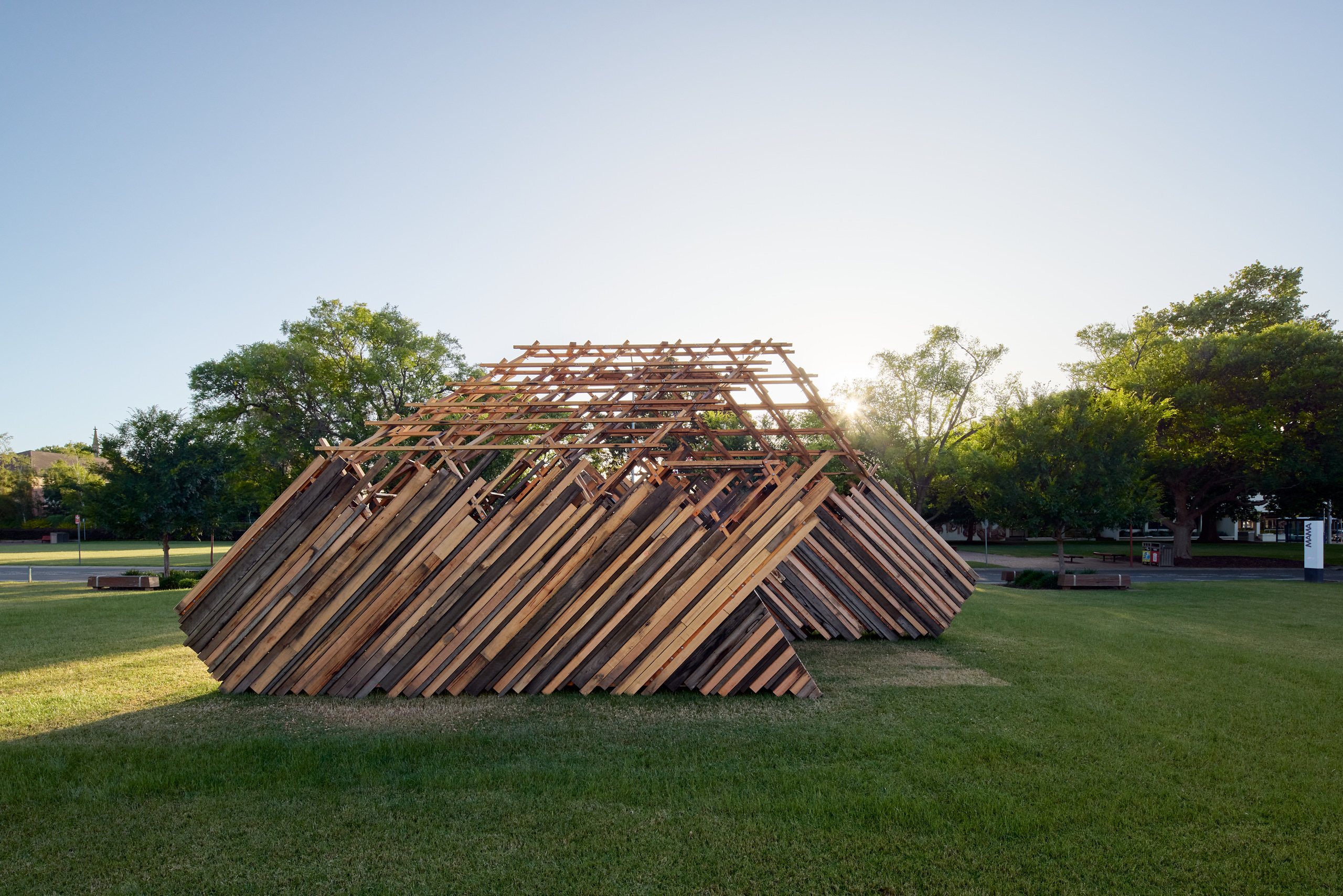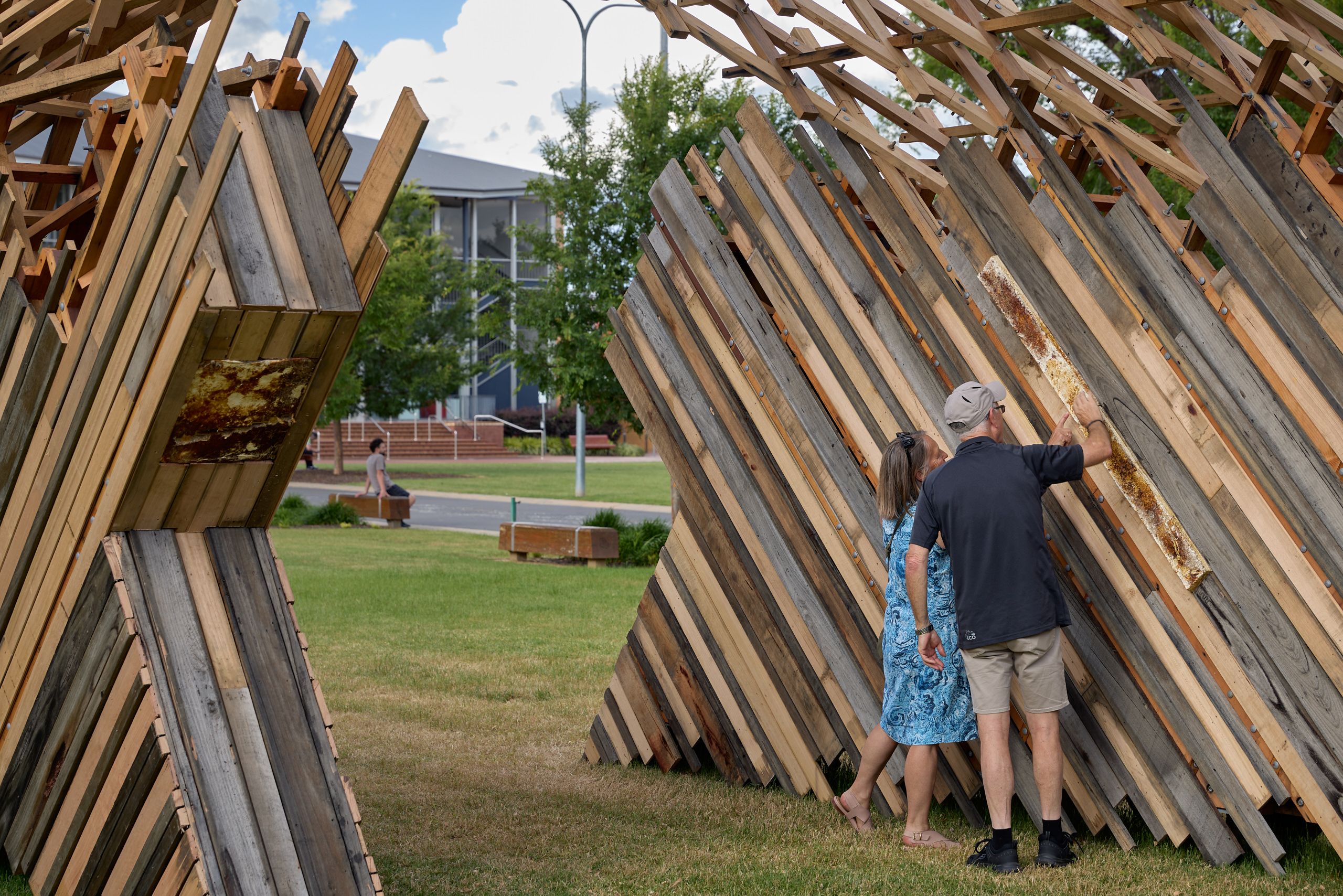Sustainable design turns waste into wonder

The yearly design of the Summer Place Pavilion is a way to showcase local architects and engage the community. Photography by Jeremy Weihrauch
In summary
- Architect, Chris Fox, has partnered with Swinburne, the University of Sydney, and Bollinger+Grohmann engineers to create the new Albury Summer Place Pavilion: Re/Place
- Re/Place was driven by the desire to explore new ways to reuse waste created in the construction industry
- It gives the local community somewhere to gather and, with the help of an interactive virtual model, teaches them about reusing materials.
The 2022 Summer Place Pavilion, Re/Place, proves that ‘one man’s trash is another’s treasure’ is more than an adage and is key to the future of sustainable design.
Everything from the piles to the last bit of timber in the project has been reused. Only the steel parts above ground (bolts, screws and base plates) are new.
The timber was sourced from local timber recycling companies; Among the Trees, in Sydney, and Timberzoo, in Melbourne. The design even made use of remnants of the pavilion from the previous year.
The process of research, exploration, and experimentation for the project was equally important to the physical outcome and proved what can be achieved with reused materials.

The density of the design and its over lapping pieces were a way of ensuring that the structure remained stable and safe despite the irregularities of reused materials. Photography by Jeremy Weihrauch
What’s so important about reuse?
Reused materials drove the decision-making for the project, leading the design instead of being a secondary consideration.
Reuse is more sustainable than recycling, as it uses less water and energy and has fewer environmental impacts.
This idea of giving materials a new life, rather than sending them to landfill, is central to the idea of the circular economy, and is vital to contemporary sustainability practises.
The current systems in place neglect this thinking, so Re/Place had to develop methods of reusing construction materials.
The project is a prototype for how construction materials can be reused and has already started conversations among local architects about how reuse can be employed more widely.
Dr. Sascha Bohnenberger-Fehr, managing director Bollinger+Grohmann and lecturer at Swinburne, was a key collaborator on the project.
“We wanted to challenge ourselves and see what could be done with a more sustainable approach,” Sascha said.

Chris Fox (left) and Dr Sascha Bohnenberger-Fehr at the Re/Place opening. Photography by Jeremy Weihrauch
Nation-wide collaboration
When Chris Fox was first invited to design the pavilion, he reached out to Dr. Sascha Bohnenberger-Fehr to collaborate with.
“We discovered very quickly that we had similar ideas about what we wanted to do with the project,” Sascha said.
From there, they brought in their university partners who were pivotal to the construction process.
The roof and roof-to-wall modules were fabricated by staff and students in Swinburne’s ProtoLAB, while the wall-to-ground elements were created in The University of Sydney’s Design Modelling & Fabrication Lab (DMaF).
Everyone worked from a highly controlled digital model and knew which elements were to be fabricated by whom.
The design was created so that the timber could be fitted together using only a spanner, so when modularized parts were sent to Albury they could be easily assembled by a local builder.

Working with a living material has many challenges but also creates highly unique results. Photography by Jeremy Weihrauch
Living building materials
The cladding for the project was also created in the ProtoLAB and DMaF by using the cutting-edge practise of casting with Mycelium.
Mycelium is the root structure of fungi, making it highly renewable and sustainable, and can be grown and set into shapes for construction.
Architectural Design Lecturer, Canhui Chen, from Swinburne, and Philip Gough, Biodesign program director at the University of Sydney both specialise in the use of Mycelium and contributed their expertise to the project.

Crafting a system for building was what underpinned the project and its exploration
Research and education beneath the surface
A live-updating digital 3D model was created by Imersian to show people how the pavilion was constructed and what materials were used.
The model will map any changes that occur over time to help inform future projects created from reused materials.
It is being expanded and will show the design’s carbon footprint and allow viewers to compare the impact that would have occurred if the structure had been made from different materials, such as new timber or steel.
Augmented reality capabilities allow viewers to see the design in their own space and use the design as an educational example anywhere in the world.
“The starting point is to introduce that concept of the circular economy to people and to educate them, to make people aware that you don't have to throw things away,” Sascha said.
-
Media Enquiries
Related articles
-

- Design
Swinburne alum launches zine celebrating Asian Australian art and identity
Swinburne Graphic Design alum Dan Truong founded HOISZN, a zine publication showcasing Asian Australian artists and their work.
Monday 01 July 2024 -

- Design
Swinburne students shine in lighting design collaboration
Swinburne students collaborated with About Space Lighting, resulting in several student-designed lamps being put into production.
Friday 07 June 2024 -

- University
Swinburne University of Technology partners with Grande Experiences and THE LUME Melbourne for cutting-edge Immersive Media education
Swinburne University of Technology is proud to announce its partnership with Grande Experiences and THE LUME Melbourne, enhancing the future of Immersive Media education.
Thursday 13 June 2024 -

- Design
Yarra Trams feature Women in Trades campaign designed by Swinburne students
School of Design and Architecture students in Swinburne’s Bureau collaborated with Tradeswomen Australia Group to design a tram wrap celebrating women in trades.
Thursday 16 May 2024 -

- Design
- Astronomy
- Technology
- University
Swinburne ‘Rock Muncher’ takes part in Australian Rover Challenge
A multidisciplinary student team from Swinburne University of Technology competed in the 2024 Australian Rover Challenge held in Adelaide, South Australia.
Thursday 11 April 2024

